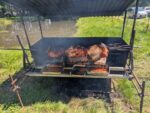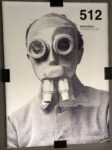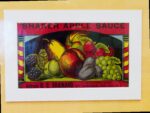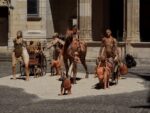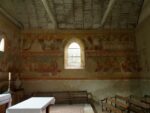As well as the highlighted links in the text,
there are comprehensive sets of photographs
– Maison Heler Metz, Curio Collection By Hilton –
– Around Metz including Marc Chagall and Jean Cocteau windows –
– Shaker exhibition and Vitra Campus and Design Museum (Weil am Rhein, Germany) –
– Bourges including Palais Jacques Coeur, Fanny Ferré sculptures and Brinay l’Église Saint-Aignan –
The printable PDF of the text is E2E2025no2.pdf (four A4 pages)
One summer when our grandson Jacob was very young, triumphant shouts of “Hay bales!” could be heard from the back seat of the car during long journeys when one game involved being the first to spot particular items, including hay bales. The prize was probably a mint sweet.
Alas, the prize was probably more gratifying for E2E children this summer, as they gloated over the flames from burning hay bales which spread towards the forest, as the firemen struggled to extinguish the blazes. Despite the lack of confirming surveillance footage, children are the main suspects in several incidents. Paul, on the other side of the village, actually spotted one of the hay bales on fire as he and a friend were setting out on a photography trip, and they called the firemen.
We are frequently annoyed that bonfires of garden rubbish are no longer allowed. But we would never have lit one close to our house at mid-day on one of the hottest days of the year, as an imprudent retired couple recently did. The charred roof-timbers of their newish house are a sad sight. But at least they are now covered with tarpaulin, unlike the pizzeria in Saulcy which has been untouched for several months, presumably because of an insurance problem.
Although far less severe than the forest fires that have raged in other areas, the village fires have nevertheless meant that the firemen have used up most of the commune’s limited water supply. So the mairie again urged restricted water use (no refilling swimming pools) and we were saving our shower and washing-up water for watering plants. The firemen were seen down our road refilling their tanks from Ludo’s large fishing pond. But we had heavy rain at the end of July, which should have started to refill the village reservoirs.
It was another fishing pond and another hot day for the annual barbecue of the Marguerites (as the club for retired people in Ste Marguerite is now called). Even the barbecue had been renamed this year as a mechoui (possibly to sound more upmarket). In fact it was not north African style lamb, but local smoked ham and we waited and waited as it slowly cooked. The marquee had been upgraded (larger and with lightweight but sturdy metal supports) so we were well shaded as we ate the home-made paté and limp salad starters and drank the rosé wine we’d brought with us. And after the smoked ham and potatoes in a creamy sauce, we had a nice religieuse (a small profiterole wedged with cream on top of a larger one, resembling a nun) for dessert. The raffle afterwards was a bit chaotic; John won a tin mug, someone had already helped themselves to Helen’s “prize”, and Paulette nearly gave us her large dark bottle of Mateus wine in disgust, thinking it was cold tea.
Helen still goes most Fridays to the Marguerites’ alternating games and brain exercise sessions. It was her turn to prepare the mental exercises and refreshments for the last session . “Don’t make them too hard” they pleaded. They struggled with a pen and paper version of battleships or demineur but fared better with calculations on the weight of the bells of Notre Dame and the cost of bunches of lily-of-the-valley! However John had made them a rich almond and chocolate cake to have at the end, which they enjoyed a lot more than the logic exercises. He got all the thanks! The two subgroups also had an “end of term” lunch together at one of the two restaurants on the Col de Bonhomme.
Talking of meals (as we so often do) we stopped after a walk for coffee at the village shop where Stephane is now running a restaurant alongside his catering business. Alas the shop has vanished apart from a shelf for baguettes and all the space is devoted to the bar run by Stephane’s partner. The menu board was chalked outside, but no one apart from us came in while we were drinking our mid-day coffees.
A more successful venue is one of our favourite Alsace restaurants, Chez Guth. After ten years it has, this year, been awarded a Michelin star. The downside is that it is much harder to get a table – we can no longer just ring up the day before. But we were lucky one day in May as they had a cancellation. Every dish was perfect, as it has to be to keep a Michelin star, so quite a burden for them now. The young waitress who had been there a long time has left and has been replaced by a mousy older woman who scurries anxiously – not quite the suave Michelin style!
We have probably mentioned that our activities this year have been restricted by various medical appointments. We are fortunate that medical services are still quite good here, despite the increasing lack of trained doctors. The Romanian surgeon who removed John’s gall bladder in early June at St Die hospital (a precautionary follow-up after a gall stone blocking John’s bile duct was removed in April) was one of the many Romanian and Hungarian doctors filling the gaps in our hospitals. After operating in the morning, he came round in the afternoon to check on John. Having in the past worked on a research project at Queen Mary College London for about 18 months and lived in Canary Wharf, his English came flooding back and he chatted for an hour about his work, living in France, and tourism in Romania, especially recommending Maramures (his wife runs a tourist agency). Amazing what you can learn after a gall bladder operation! But what happened to his other patients that afternoon?
As for the kestrels (whose return to our attic window ledge we mentioned at the end of our last newsletter) they had duly laid eggs and, at the same time as John went down to surgery that day, the first egg hatched. We had five little fluffy white chicks on the windowsill until the weakest died and was eaten. The remaining four thrived, tested their wings and eventually flew away. Will they return next year?
Meanwhile, we too were feeling restless. So we planned a couple of short breaks in July between a couple of procedures to remove a melanoma and then the surrounding tissue on John’s shoulder. John had read with interest about a new hotel in Metz designed by industrial architect/designer Philippe Starck with its whimsical 19th century style villa perched on top of a multi-storey concrete block. We booked a room there for a couple of nights as John had an appointment nearby for a bone scintigraph. We began to wonder if the hotel had actually opened as our e-mail about parking was not answered and the phone-line was not working. On arrival the hotel receptionist was off-hand about their lack of response and phone contact, and demanded a deposit (did we look as if we were about to destroy our room or run up a huge unpaid bar bill?). Disconcertingly, our fifth floor corridor was lined with photos of men in gas masks and of explosive devices and was carpeted with strange symbols. Design seemed more important in our room than guest comfort. Stark had written a strange, slim novel about an fictional inventor Manfred Heler and his love Rose which apparently explains the gas mask inventions and coded symbols on the walls and carpets. The restaurants are named after the two characters, but looked pretentious and we escaped to cheaper Italian ones. Sadly the current exhibitions in the nearby Pompidou Centre were also not to our taste. The following day we revisited the Cathedrale Saint-Etienne de Metz with its Chagall windows, the Cocteau windows in St.Maximin and the painted Templars’ chapel.
The following week we had a more successful trip to Wihr am Rhein, across the Rhine from Basel, where there was an exhibition on the Shakers, their culture and furniture at the Vitra Design Museum. It was fascinating, not only exhibiting chairs (inventive tilting feet, wheelchairs, shoemaker’s unit), tables, and cupboards (including for sewing) but also details of their worship, community celibate living, and produce and seed trading. The rest of the Vitra site was also interesting with architect-designed modern buildings for their high quality furniture production, the Charles and Ray Eames archive, a good café and attractive gardens. We had a comfortable traditional hotel this time and a very good evening meal in the nearby restaurant Café Gupi, partly furnished and decorated from Vitra.
Once John had been stitched up after his second melanoma procedure, and the nurse had changed the dressings several times, we again felt itchy feet so booked a last-minute four-night stay in Bourges in early August. The weather got hotter, but the narrow streets of criss-crossed timbered houses around the cathedral were shady and picturesque to stroll around. We spent a long time looking at the thirteenth century stained glass windows in the cathedral apse, with their detailed illustration of the parables and the lives of saints. The most unexpectedly enjoyable visit was to the 15th century Palais Jacques Coeur. Having had his elaborate palace constructed, the wealthy financier was disgraced and imprisoned, and never lived there. But what gave interest to the unfurnished rooms were the life-sized clay figures of trudging, exhausted travellers (like troubadours or dispossessed exiles) who plodded across the courtyard and rested in the rooms. 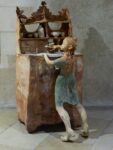 They were selected by their sculptress Fanny Ferré to reflect the themes of the rooms (a child surreptitiously stealing food in the kitchen/pantry, a woman regarding her bottom in a mirror in the steam room, musicians suspended from a ceiling upstairs, a row of puzzled children on a bench in the study). Both of us recalled our childhood sensations of flying as we looked at the statues of winged children (definitely children not cherubs). And what were many of the grouped figures looking upwards towards?
They were selected by their sculptress Fanny Ferré to reflect the themes of the rooms (a child surreptitiously stealing food in the kitchen/pantry, a woman regarding her bottom in a mirror in the steam room, musicians suspended from a ceiling upstairs, a row of puzzled children on a bench in the study). Both of us recalled our childhood sensations of flying as we looked at the statues of winged children (definitely children not cherubs). And what were many of the grouped figures looking upwards towards?
We also explored some of the villages around Bourges: Brinay with its beautiful 13th century frescoes in St Aignan church; La Borne with its disappointing, lumpy pottery; La Chapelle d’Angillon, birthplace of author Alain Fournier, where he returned every summer to stay with his grandparents and the Chateau de la Verrerie which inspired the scenes of the enchanted, lost world of Fournier’s Le Grand Meaulnes. Someone was playing the piano as we sat in the courtyard of the lakeside château – like an echo of Meaulnes’ elusive love. On the way home we stopped to see the market and cathedral in Sens.
It made an interesting start to August. And, as all was well when John’s stitches were removed, we will shortly be on the move again – this time to Letchworth which has been sadly neglected since our April/May visit. As ever, we are looking forward to seeing family and old UK friends again.

